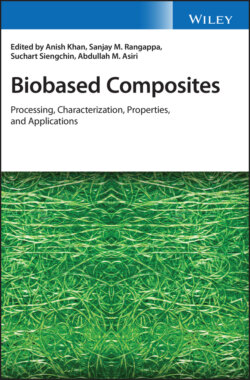Читать книгу Biobased Composites - Группа авторов - Страница 21
1.6 Life‐cycle Assessment
ОглавлениеThe Life‐cycle assessment (LCA), as the name implies, is an assessment method of the environmental impacts along the whole life of the product, starting from preparing the raw materials, and passing through producing, distributing, using, maintaining, and ending by disposing or recycling. Designers use this method in evaluating their products. It can widen the view of the environmental concerns through compiling an inventory of relevant energy and material inputs and environmental releases; assessing the potential effects accompanying the identified inputs and outputs; and helping in adopting more realistic decisions. In general, the LCA used an iterative process to arrive at the results. These results provide further information to the production process and guide toward the most important environmental input or output that should be highly monitored. Several case studies for the environmental impacts of the life cycle of many products were reported in the literature [60–64]. All the studies conclude that the LCA is an effective tool to assess the environmental impacts of the different products along their life, as well as it aids in selecting ecofriendly materials. Hence, using LCA in planning and management strategies helps in delivering more sustainable products and protecting the health of the people. The extra information obtained from LCA can help in improving the inventory analysis, and in adopting more informative decisions. Further environmental improvements can be achieved using LCA through evaluating the potential effects accompanying specified inputs and outputs.
There are three types of LCA; these are: conceptual, simplified, and detailed. These types can be applied in many ways where each type has its own strengths and weaknesses. The life cycle of each product passes through many stages starting from extracting and preparing the raw materials, manufacturing, distributing, storing, using, and ending by disposing or recycling the products to reduce the environmental effect.
Recycling is defined as converting the materials and the products at the end of their life to new useful products. It exploits the potentially useful materials from waste, reduce the demands for raw materials, reduce the energy consumption, and reduce the air and water pollutions. Each stage of the LCA have inputs (raw materials and energy) and outputs (gas emissions and solid wastes). Thus, the role of the LCA is to study the environmental impacts of these inputs and outputs on each stage of the product life, and trying to reduce these impacts and deriving the potential benefits from them. The LCA is composed of four phases:
Goal and scope
The purpose of this study is to select a product and determine the objective of the study (comparison, improvement) and fix boundaries accordingly.
Inventory analysis
Collecting as much information as possible on the inputs and outputs at each stage of the product life.
Impact analysis
Studying the environmental impacts of the inputs and the outputs at each stage of the product life.
Interpretation
Using the data and information collected, the product life cycle will be improved, and the environmental impact will be reduced.
The LCA is performed by passing over these phases frequently in an iterative manner.
